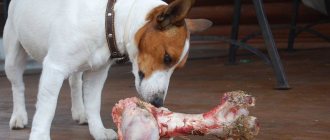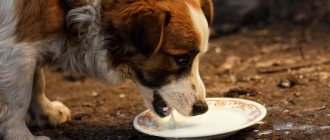Can dogs be given chicken?
Dog breeders switch their dogs to a natural diet, starting with chicken, which is considered a dietary food with significant energy value.
Poultry protein is well absorbed and digested. However, chicken as food is not suitable for all dogs, with the exception of individuals with a problem pancreas and individual intolerance, manifested by allergic signs or digestive disorders. New food is introduced gradually, monitoring the body's reaction. Responsible dog owners feed their pets poultry from their own home range or products of proven quality purchased in the store. The meat is served to the dog raw or cooked, and parts with bones are given with caution.
Dogs that should not eat chicken
Chicken or chicken should not be given to dogs with an individual intolerance or allergy to this product. If, when feeding your pet chicken, you notice that he has redness, a rash, earwax, and he begins to itch, first of all, eliminate chicken from the diet. If the symptoms disappear over the next few days, then the bird is the cause of the allergy.
In addition, this type of meat, and even more so chicken broth, is contraindicated for four-legged animals with a weak pancreas and a problematic gastrointestinal tract.
Chicken and chicken by-products, specifically paws, heads, and necks, should be given to small breed dogs with caution. Their jaw apparatus is not as powerful and strong as that of large dogs. They can swallow bones without chewing, and, as a result, digestive problems may arise.
Is it possible to feed it to a dog all the time?
In a dog’s diet, the meat diet is fundamental. Essential nutritious protein is found in beef, lamb, rabbit and other types of meat. You can't feed your dog only poultry. Chicken serves to diversify the main menu, but is not suitable for all dogs - in some it gives rise to allergic symptoms.
Take the Attention Test! Find 10 differences! (click right here!)
Find the answer Are you bothered by some problem or question? Enter “Breed” or “Name of the problem” into the form, press Enter and you will find out everything about the issue that interests you.
Can puppies and pregnant women eat chicken?
Chicken meat can be fed to puppies and pregnant females if its digestibility is normal.
A puppy’s transition to solid food usually begins with chicken meat; if there are no problems with digestion, chickens can be safely included in the diet. It is important to consistently introduce the puppy to other types of meat, offal, and fish.
Food for pregnant bitches should be nutritious and balanced. Poultry protein, having energy value, is well absorbed and supplies the body with the necessary amino acids. With natural feeding, chicken, along with other types of meat, is necessarily included in the menu for females expecting offspring.
How to properly feed your dog chicken
The main part of the bird carcass consists of cartilaginous bones, meat and offal.
Dogs are allowed to feed:
- meat;
- heads;
- neck;
- stomachs and hearts;
- liver;
- frame (back);
- paws and wings.
It is prohibited to give:
- tubular bones;
- boiled bones.
Chicken meat is nutritious, tender, full of protein, containing few harmful fats, suitable for puppies and adult dogs to eat, safe for consumption - if it does not provoke allergies, it can be fed raw or boiled.
Bird heads are considered a healthy by-product due to their brain content. However, it is not advisable to feed them to small individuals with weak jaw apparatus. Large and medium-sized dogs with strong jaws can easily chew through soft head bones. Before serving, be sure to remove the beak; this part is not digested by the dog’s stomach, causing a risk of damage to the esophagus.
The necks will serve as a tasty treat for your pet; they are fed to representatives of small breeds and six-month-old puppies. The necks are not boiled, they do not contain dangerous bones, but for small dogs the bones are first softened by beating with a special hammer.
The ventricles and hearts are boneless, contain valuable microelements, and are safely served to all dogs who do not suffer from allergies. These by-products are fed raw or boiled and combined with vegetables and cereal porridges.
Liver is rich in protein, vitamins A and B. It is given raw or boiled, no more than 2 times a week, since, acting as a filter, it concentrates harmful substances that enter the bird’s body from feed; excessive consumption of liver leads to diarrhea . It is better to consume offal from domestic chickens raised without the use of hormonal drugs.
The backs are given raw and only to large individuals who can chew and carefully gnaw the bones.
Paws and wings are rich in amino acids and collagen, necessary for the healthy state of the dog’s musculoskeletal system. Parts of the carcass are given raw or they are used to make rich jellied meat. First, be sure to remove the tubular knuckles from these bird parts and cut out the claws from the paws.
It is forbidden to give dogs any boiled or tubular bones; under the influence of the dog’s teeth, they crack into sharp pieces like glass; if such fragments get into the esophagus, they injure the stomach and intestines, which leads to bad consequences for the pet.
It is not recommended to offer chicken skin; other than fat, it has no health benefits.
The owner needs to try to teach the dog to chew food, at first he will have to offer to feed from his hand, holding a piece, promoting gradual eating, so the animal will begin to chew the food rather than swallow it whole.
Bone-containing by-products should not be boiled; they should be offered with caution to puppies and small breeds who have difficulty chewing.
Many dog breeders refuse to offer chicken paws, wings, heads, and backs to their dogs, considering them potentially dangerous due to the presence of bones. For a puppy or small dog, it may be better to avoid such treats; if the dog chews solid food thoroughly, then parts of the carcass with soft bones do not pose a danger. Feeding each dog must be approached individually.
Is it possible to give chicken necks?
The neck is exactly the offal that will be useful not only for an adult dog, but also for a small 3-month-old puppy. To prevent chicken neck from losing its beneficial properties, it is not advisable to cook it, especially since when boiled this offal, like bones, can clog the stomach and intestines. Chicken necks can be given exclusively raw, either whole or twisted into minced meat. Before use, the product must be doused with boiling water.
Difference between cooked and raw chicken for dogs
For all dogs who do not suffer from allergic symptoms, chicken and a non-concentrated broth based on it are suitable for food variety. The pet will receive more nutrients from a raw product, but there is a risk of infection with salmonella or other bacterial infection, so most owners feed the bird only after heat treatment.
Uncooked bird bones (not tubular) are soft and easily processed by the stomach; boiled bones are dangerous to the health of the animal; when cooked, they become fragile, and when chewed, they crumble into sharp particles that can injure the walls of the esophagus. The bone parts of the carcass are not boiled, but are doused with boiling water against bacteria.
Chicken by-products for a dog: to give or not to give?
A properly designed diet for a dog is the key to its health and beauty. The owner immediately wonders what exactly to feed his pet. Offal has always been a question: is it possible to give chicken necks, paws, and heads to a dog? In this article we will try to find answers to these questions.
First, let's figure out what by-products are. By-products are by-products of the body that remain when cutting a carcass: head, neck, bones, skin, etc. They are stored for no more than four months, even at low temperatures. After the expiration date has expired, they should not be given to your pet. But if your dog eats it, take it to the vet immediately.
There is a BARF feeding system that involves the use of chicken by-products, but only in raw form.
However, most veterinarians believe that chicken bones should not be given. For gnawing there are beef (muscles) or cartilage.
In no case should you eat boiled bones, because just when cooked they become dense and sharp, and are not digested in the stomach, and can also damage the stomach and intestines.
In addition, they are in no way a source of calcium, as many people think, since they contain it in a modified form.
When feeding puppies, you must not forget about dry food, because in its pure form by-products can be harmful to the baby. You also need to carefully monitor your pet's behavior. If diarrhea or vomiting begins, you should immediately remove the food that the dog ate from the diet.
Bones
Whether to give your dog chicken bones is a very tricky question because the answer can be yes or no. Under no circumstances should you give your pet boiled chicken bones. If you ask why, the answer is simple: when cooked, the bones become so soft that they almost turn into a homogeneous mass. This is all very, very harmful for the pet.
Boiled bones clog the stomach, where only in some very rare cases everything will work out without problems. More often, surgery may be needed to remove bones from the stomach.
Next, what you should pay attention to: tubular bones from paws and wings should not be given under any circumstances. If a pet chews them, the fragments can rupture the intestines.
After this, the owner will face a difficult struggle with peritonitis and other horrors. You will have to do an operation, where in the best case the dog can be saved after hellish torment, in the worst case – not. Therefore, it is always worth thinking carefully about the lengths to which kindness can take you.
If your dog has already eaten bones, you need to keep a close eye on his feces. And don’t wonder why the bloody marks appeared, but immediately take your pet to the veterinary hospital.
Of course, you shouldn’t give up chicken bones, as was said at the beginning of the article. Chicken bones do help form and strengthen joint cartilage. The bones will be a nutritious addition to the main feed.
Heads
You can feed your dog chicken heads. This should be done with caution and not overdo it. Before adding chicken heads, previously cut into pieces, to porridge or vegetables, you should get rid of the beak. The beaks lack useful substances and are not digested.
When decocted, the head loses half of its energy value, so the portion should be doubled. And make sure that there are no bone fragments, for example, from the neck.
Necks
With necks everything is exactly the same as with bones. It is not advisable to cook necks, as this will lead to intestinal obstruction and loss of nutrients. You can give it whole, because there are no tubular bones in the necks. Thanks to this, even two-month-old puppies can eat the necks.
The necks can also be scalded with boiling water and added to the main diet in the form of minced meat, as a top dressing. Your pet will happily chew on chicken necks.
Paws
Paws, like other offal, are questionable. If you ask dog lovers, opinions are as different as heaven and earth. Some are for, others are categorically against. Let's dig deeper.
So, if you decide to feed your dog with its paws, there are a few rules you need to know:
- remove bones;
- remove claws;
- Pour boiling water over your paws.
Why should you do all this? Claws can injure the stomach, as well as the bones that make up the paws. The bones in the paws are tubular and if a dog chews them, a splinter can rip open the esophagus. This is why you need to remove all the chicken bones. Of course, you can soften them if you cook them for a long time, but then they will clog the intestines, and this is of no use to your pet.
A good option to avoid problems with the intestinal tract is to cook jellied paws, removing all bones and fragments. Jellied meat, in fact, is not difficult to cook; any owner can handle it. But not everyone knows that it is in the bones that toxins and other harmful substances accumulate.
Jellied paws are good to use in limited quantities during the growth period of the animal; it contains natural gelatin, which helps strengthen and support joints.
Therefore, you cannot constantly give your dog paws. It's better to do this less often than more often. Paws should be a bonus to the main more nutritious and healthy diet. If the dog has eaten its paws and begins to show poor health, it should be immediately taken to the veterinarian.
Veterinarian recommendations
Regarding chicken bones, necks, heads, paws and other offal, veterinarians have different opinions. Some allow the possibility of feeding them, others do not.
Here are some recommendations from qualified specialists:
- By-products should be given to your pet raw, because this way more nutrients remain. If you are not sure that they are of high quality and do not carry infection, it is better, of course, to boil them. And remove the bones.
- Always monitor the reaction of your pet's intestines and skin to avoid problems. It is not advisable to feed chicken skin.
- To help your dog eat more nutrients, you can increase the portion of cooked offal. Why? Because during cooking, all the energy value is lost.
- It is recommended to feed your pet by-products no more than 1-2 times a week, together with the main food.
- If you decide to switch to natural food, you need to give your pet time to get used to it. Side effects such as vomiting and diarrhea may occur.
- You cannot give offal of different types at the same time: fermented milk and meat.
Veterinarians also recommend carefully monitoring what your dog eats.
By-products should only be purchased from trusted people and places that are trustworthy. You should not buy food for your pet in suspicious places where bacteria can spread.
Doctors also strongly recommend taking a closer look at your pet’s first reactions to feeding chicken by-products. After all, what is good for one dog can be harmful for another.
"What to feed a dog"
In this video you can learn about the foods you can feed your pet.
Loading …
Source: https://dalmspb.com/food/kurinye-subprodukty-sobake-9078/
What can replace chicken?
An alternative is turkey, it is low in calories, rich in vitamins A, E, potassium, sodium, magnesium, iron, has little fat, and is easily digestible. The process of raising this bird is rarely accompanied by the use of hormones and antibiotics; most dog lovers prefer turkey meat when creating a menu for their pet.
Usually, with natural feeding, the basis of the diet is beef, rich in nutrients, but it does not contain all the necessary microelements.
Other alternative meats include:
- mutton;
- horsemeat;
- venison;
- pork;
- rabbit meat.
Lamb is valued for its high potassium and magnesium content and low cholesterol.
Horsemeat is easily digestible, rarely causes an allergic condition, but is of little nutritional value for active dogs.
Venison is valued for its usefulness and uniqueness, has a beneficial effect on cardiac activity and the functioning of the gastrointestinal tract, and is considered a delicacy; not every owner will be able to pamper a pet with such a treat if he is not a hunter.
There is a lot of controversy about pork; many owners prefer to find an alternative to it or only serve it boiled.
Rabbit meat is a healthy product, but is contraindicated for animals with kidney and biliary tract diseases.
It is important for the animal to organize a balanced diet, including dairy products, eggs, fish, cereals, fruits, vegetables, and herbs.
How long to cook chicken feet for a dog
The duration of heat treatment depends on two main factors:
- product quality;
- age and health of the animal.
It is advisable to give chicken feet to an adult healthy dog raw, like other meat products, after removing the tubular bones and claws and dousing them with boiling water. This way the product is more easily absorbed by the dog’s digestive system and does not lose its beneficial properties. If the quality of the purchased offal is in doubt, it is worth boiling the paws for 10 minutes before feeding them to your pet.
To feed a puppy, on the contrary, the offal should be thoroughly boiled. A weak immune system is susceptible to infectious diseases, and an undeveloped jaw apparatus and digestion cannot cope with the processing of hard food on their own. The ideal paw dish for a puppy is chicken paw jellied meat. Chicken feet must be washed, boiled for 30-40 minutes, bones and claws removed and chopped. Then mix with the broth and cook the jellied meat with the addition of gelatin. The delicacy will retain all the beneficial substances in an easily digestible form.
Older dogs have a strong immunity to infections, so long-term cooking is not required. It is enough to boil the chicken feet for 5-10 minutes, or just rinse and rinse with boiling water. This will preserve the collagen content unchanged and eliminate the use of chemical chondroprotectors. However, the digestive system of dogs weakens with age, so you should feed offal in moderation, while maintaining control of your pet's digestion.
What are the benefits of chicken for dogs?
Chicken is considered a dietary product with a high energy component, containing easily digestible protein, amino acids, vitamin B, phosphorus, potassium, calcium, magnesium and other microelements.
Chicken by-products are also considered useful:
- stomachs are valued for their fiber, which improves digestion and intestinal function;
- the liver is rich in protein and vitamin A, which has a beneficial effect on skin and vision;
- paws contain collagen, which maintains the normal state of the musculoskeletal system;
- necks have soft bones that promote the development of dog jaws.
Only a fresh, high-quality product brings benefits.
Benefit
The most useful thing in a chicken head is the brain. It contains a huge amount of vitamin B12, which contributes to the normal development of the muscular and nervous system, and also supports the formation of antibodies in the blood.
Veterinarians often recommend that owners of dogs of racing and hunting breeds add chicken heads to their pet’s diet, or, if the dog is accustomed to eating commercial food, add nutritional supplements in the form of tablets with B vitamins.
Reference! A deficiency of vitamin B12 in a dog's diet can lead to hypovitaminosis and anemia.
In addition, per 100 g of product there are 17 grams of pure protein, which is quite a decent indicator for an offal of this kind.
This part of the chicken carcass does not contain tubular bones, which means that the risk of the pet choking or damaging the esophagus is minimal. The chicken skull itself contains calcium, which is necessary for strengthening teeth and bones.
Why is chicken harmful to your pet?
The harm lies in individual intolerance to the product; low-quality or expired products also cause damage to health. It is advisable to use poultry raised in natural village conditions or buy chicken from sellers who are responsible for the quality of their product. Some producers on poultry farms add hormonal substances and antibiotics to feed; eating chickens filled with such drugs will harm the development of puppies and the health of adult dogs. “Hormonal” food provokes early puberty and improper skeletal formation in dogs, causing digestive disorders and allergic irritation.
Fatty chicken broth is harmful to the pancreas, liver and gastrointestinal tract of the animal.
Boiled and tubular chicken bones are dangerous; when they crumble into fragments, they damage the esophagus, leading to serious complications, including death.
How to cook
How long should you cook chicken necks before they are ready? Usually 20-25 minutes is enough. During this time, the meat will be completely cooked. When finished, it can be mixed with some healthy cereal. Some people ask: how long to cook chicken feet, since they are also edible?
The heat treatment time in this case is not particularly long - 15-18 minutes. You need to try in every possible way to diversify your pet’s menu. There are no particular difficulties in cooking, but you have to waste your time and make extra efforts.
Allergy to chicken in a dog
Chickens, along with other foods, sometimes cause an allergic reaction. Chicken protein intolerance is often found in dogs; some breeds (dachshunds, Labradors, bulldogs, etc.) are predisposed to food intolerance. It is necessary to responsibly plan the diet of sensitive individuals.
Symptoms:
- skin itching;
- rash;
- discharge;
- edema;
- unpleasant odor;
- digestive disorder.
Because of the itching, the dog begins to scratch the skin, it may peel, redness, papules form near the anus, in the abdomen, armpits, on the face, often the irritated areas become wet and covered with crusts. Discharge appears from the eyes, ears, nose, and swelling occurs. The fur begins to smell bad and diarrhea appears.
The allergic condition has an individual character, one dog eats a certain food in large quantities, and another will have a negative reaction.
The allergen is determined by adjusting the feeding; if chicken is suspected, it is completely removed from the diet and the dog’s condition is monitored. The main method of treating food allergies is diet. In some cases, the veterinarian recommends switching the dog to special food.
Usually, after eliminating the allergen, the symptoms quickly go away, but sometimes drug intervention is required to prevent complications; antihistamines, antipruritic ointments and antiseptics, diuretics that help eliminate swelling are used, and immunomodulatory medications are additionally prescribed by the veterinarian. Medicines are selected individually; effective treatment of the dog will only be carried out by a veterinarian.
What else you need to pay attention to:
1.When buying chicken necks for your dog, look carefully at the expiration date. Remember that when stored for a long time they lose nutrients. 2. Try to buy environmentally friendly “raw materials” grown without growth hormones and antibiotics... 3. When introducing chicken necks into the diet, you need to monitor the reaction of the dog’s body - how the dog’s digestive tract works (is there any stool disorder) or allergic reactions.
I found an interesting video in which the famous doctor Komarovsky talks with a specialist about whether industrial broiler chicken poses a danger to children’s health. Are they myths or truth, see for yourself! The video is short.











